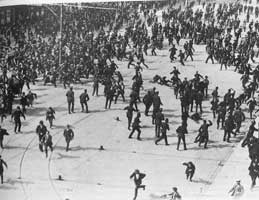Related Research Articles

The National Union of Seamen (NUS) was the principal trade union of merchant seafarers in the United Kingdom from the late 1880s to 1990. In 1990, the union amalgamated with the National Union of Railwaymen to form the National Union of Rail, Maritime and Transport Workers (RMT).

The Dublin lock-out was a major industrial dispute between approximately 20,000 workers and 300 employers which took place in Ireland's capital city of Dublin. The dispute lasted from 26 August 1913 to 18 January 1914, and is often viewed as the most severe and significant industrial dispute in Irish history. Central to the dispute was the workers' right to unionise.
The Workers' Union was a general union based in the United Kingdom, but with some branches in other countries. During the 1910s, it was the largest general union in the UK, but it entered a rapid decline in the 1920s, and eventually became part of the Transport and General Workers' Union (TGWU).

The Minneapolis general strike of 1934 grew out of a strike by Teamsters against most of the trucking companies operating in Minneapolis, the major distribution center for the Upper Midwest. The strike began on May 16, 1934 in the Market District. The worst single day was Friday, July 20, called "Bloody Friday", when police shot at strikers in a downtown truck battle, killing two and injuring 67. Ensuing violence lasted periodically throughout the summer. The strike was formally ended on August 22.
New Model Trade Unions (NMTU) were a variety of Trade Unions prominent in the 1850s and 1860s in the UK. The term was coined by Sidney and Beatrice Webb in their History of Trade Unionism (1894), although later historians have questioned how far New Model Trade Unions represented a 'new wave' of unionism, as portrayed by the Webbs.
The National Union of Vehicle Workers was a trade union representing drivers in the United Kingdom.
The United Vehicle Workers was a trade union representing drivers in the United Kingdom.
The Liverpool and District Carters' and Motormen's Union (LDCMU) was a trade union representing cart drivers in the Merseyside area of England.
The Scottish Commercial Motormen's Union was a trade union in the United Kingdom. It merged with the Transport and General Workers' Union in 1971.
Taxis in Australia are highly regulated by each Australian state and territory, with each state and territory having its own history and structure. In December 2014, there were 21,344 taxis in Australia. Taxis in Australia are required to be licensed and are typically required to operate and charge on a fitted taximeter. Taxi fare rates are set by state or territory governments. A vehicle without a meter is generally not considered to be a taxi, and may be described, for example, as a hire car, limousine, carpool, etc. Most taxis today are fuelled by liquid petroleum gas. Cabcharge Australia owns and operates the Cabcharge payment system, which covers 98% of taxis in Australia, and operates one of Australia's largest taxi networks.

The Great Strike refers to a near general strike that took place in New Zealand from October 1913 to mid-January 1914. It was the largest and most disruptive strike in New Zealand's history. At its height, it brought the economy of New Zealand almost to a halt. Between 14,000 and 16,000 workers went on strike, out of a population of just over one million.

The London Trades Council was an early labour organisation, uniting London's trade unionists. Its modern successor organisation is the Greater London Association of Trades (Union) Councils
Trade unions in Curaçao have a total membership of 5,800, as of 2009.
The South African Railways and Harbours Union was formed by black workers of the South African Railways and Harbours Administration after they had been expelled from the National Union of Railway and Harbour Servants.
The London builders' strike of 1859 was a strike and resulting lock out of building trade workers across London. The action did not result in any changes to working conditions, but it led to the formation of new, national trade unions in the United Kingdom.
Hugh Lyon was a Scottish trade union leader.

The Electrical Trades Union (ETU) was a trade union representing electricians in the United Kingdom, much of its membership consisting of wiring fitters and telephone engineers.
The Blackburn and District Weavers' Winders' and Warpers' Association was a trade union representing cotton industry workers in Blackburn, Lancashire, in England. One of the earliest weavers' unions to endure, it formed a model that many others copied, and was at the centre of early attempts to form a regional federation of cotton trade unions.
The Oldham Provincial Card and Blowing Room and Ring Frame Operatives' Association was a trade union representing cotton industry workers in Oldham, Lancashire, in England. Long the largest union in the industry, it played a leading role in establishing a regional federation of cardroom workers.

The Amalgamated Association of Tramway and Vehicle Workers (T&VW) was a trade union representing workers on public transport in the United Kingdom.
References
- 1 2 3 4 Marsh, Arthur; Ryan, Victoria (1987). Historical Directory of Trade Unions. 3. Aldershot: Gower Publishing Company. pp. 230–240. ISBN 0566021625.
- ↑ "London and Provincial Union of Licensed Vehicle Workers". Modern Records Centre. University of Warwick. Retrieved 1 June 2018.